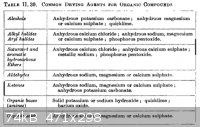organicchemist25
Hazard to Others
  
Posts: 136
Registered: 12-2-2014
Member Is Offline
Mood: No Mood
|
|
ACS grade 200 proof Ethyl Alcohol
I have done some searching, and would still like to know if 200 proof ethyl alcohol will absorb moisture from the air?
I know about alcohol and H2O's azeotrope, but will 200 proof just absorb moisture from the air to obtain the natural azeotrope with alcohol and the
H2O?
The test date on my gallon of 200 proof EA is 2016.
I just want to know if its a major concern or not, since the 200 proof EA is so expensive.
|
|
|
UnintentionalChaos
International Hazard
    
Posts: 1454
Registered: 9-12-2006
Location: Mars
Member Is Offline
Mood: Nucleophilic
|
|
Yes, anhydrous ethanol is agressively hygroscopic and will absorb water from the air rapidly.
Department of Redundancy Department - Now with paperwork!
'In organic synthesis, we call decomposition products "crap", however this is not a IUPAC approved nomenclature.' -Nicodem
|
|
|
Nickdul
Hazard to Self
 
Posts: 96
Registered: 13-2-2012
Location: Bulgaria
Member Is Offline
Mood: No Mood
|
|
I'm not sure if anhydrous copper sulfate can be used to detect water in minute quantities; but is a quick way to ensure that it has not absorbed a lot
of water. Maybe cobalt chloride?
|
|
|
Tsjerk
International Hazard
    
Posts: 3022
Registered: 20-4-2005
Location: Netherlands
Member Is Offline
Mood: Mood
|
|
Have a look at this article: I don't know if you have access from where you are now, I don't at least, but the abstract looks good.
http://onlinelibrary.wiley.com/doi/10.1002/jccs.200700089/ab...
|
|
|
ZIGZIGLAR
Hazard to Self
 
Posts: 79
Registered: 3-2-2014
Member Is Offline
Mood: No Mood
|
|
"Water can be qualitatively detected down to 500 ppm by the formation of a precipitate when
aluminum ethoxide in benzene is added to a sample of the ethanol . Quantitative determination of water is carried out by Karl Fischer titration. An
automated coulometric Karl Fischer titration has been described (ref. 2) that has a limit of determination of 5 ppm. Some
corrmercial instruments have by now an even better performance."
REFS:
1. Anon., Merck Standards, Merck, Daxmstadt, 1971.
2. A. S. Lavrenova, I. P. Ogloblina, V .A. Fedorov, N.P. Kuznetsova, Metody Anal. Khim.
Reaktivov Prep., 18, 39 (1971); C.A. 77, 147 319 j.
Anhydrous absolute ethanol will most likely reduce to around 99.5% purity if exposed to the atmosphere. I think it's best to store it on 3A molecular
sieves with minimal headspace in the reagent bottle and obviously best to transfer under inert gas where possible. If not, you might as well buy 99.5%
grade and save some money.
[Edited on 19-2-2014 by ZIGZIGLAR] Had to correct some spelling errors from a bad OCR conversion, sorry.
[Edited on 19-2-2014 by ZIGZIGLAR] http://en.wikipedia.org/wiki/Karl_Fischer_titration
[Edited on 19-2-2014 by ZIGZIGLAR]
[Edited on 19-2-2014 by ZIGZIGLAR]
|
|
|
feacetech
Hazard to Others
  
Posts: 163
Registered: 12-2-2007
Member Is Offline
Mood: No Mood
|
|
Or keep some sodium wire in the bottle to keep the ethanol dry
|
|
|
TheChemiKid
Hazard to Others
  
Posts: 493
Registered: 5-8-2013
Location: ̿̿ ̿̿ ̿'̿'̵͇̿̿з=༼ ▀̿̿Ĺ̯̿̿▀̿ ̿ ༽
Member Is Offline
Mood: No Mood
|
|
That would not work in the slightest. Sodium reacts with ethanol!
When the police come
\( * O * )/ ̿̿ ̿̿ ̿'̿'̵͇̿̿з=༼ ▀̿̿Ĺ̯̿̿▀̿ ̿ ༽
|
|
|
subsecret
Hazard to Others
  
Posts: 424
Registered: 8-6-2013
Location: NW SC, USA
Member Is Offline
Mood: Human Sadness - Julian Casablancas & the Voidz
|
|
Keeping elemental sodium in ethanol will form sodium ethoxide, IIRC.
2 CH3-CH2-OH + 2 Na -> 2 CH3-CH2-ONa + H2
Vogel's Practical Organic Chemistry states that MgSO4 and CaSO4 are drying agents well-suited for alcohols.
Speaking of which, here's a table of drying agents...

Fear is what you get when caution wasn't enough.
|
|
|
ZIGZIGLAR
Hazard to Self
 
Posts: 79
Registered: 3-2-2014
Member Is Offline
Mood: No Mood
|
|
As listed above, quicklime or CaO is the most widely used dessicant for Ethanol, but, for storage purposes, you want something that isn't miscible,
like molecular sieves. Ethoxide is pretty useful, but not when you actually want anhydrous ethanol for impurity sensitive reactions.
|
|
|